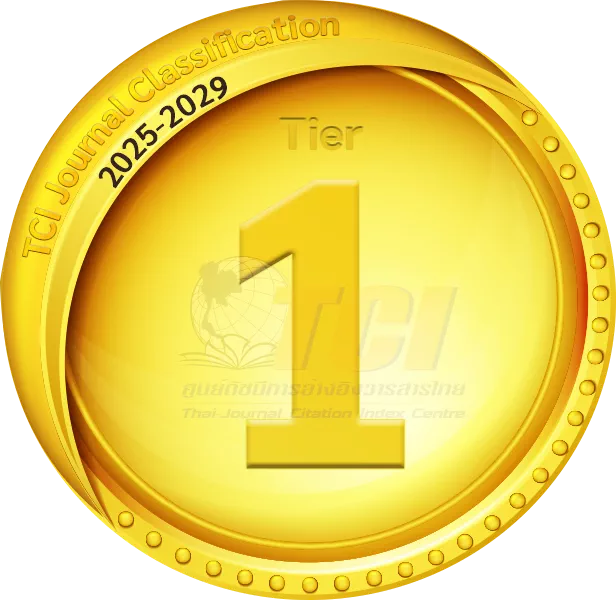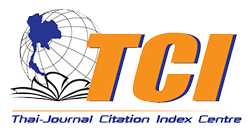ผลกระทบของความชื้นต่อสมรรถนะและคุณภาพของเชื้อเพลิงอัดเม็ดจากชานอ้อย
Effects of Moisture Content on the Performance and Quality of Sugarcane Bagasse Biomass Pellet
Abstract
การศึกษานี้มุ่งเน้นการวิเคราะห์ผลกระทบของระดับความชื้นที่แตกต่างกัน (10 15 และ 20 เปอร์เซ็นต์) ต่อสมรรถนะและคุณภาพของเชื้อเพลิงอัดเม็ดจากชานอ้อยคั้นน้ำ ซึ่งเป็นวัสดุเหลือใช้ทางการเกษตรที่มีศักยภาพในการนำไปแปรรูปเพื่อเพิ่มมูลค่า การทดลองพบว่า ระดับความชื้น 15 เปอร์เซ็นต์ เป็นค่าที่เหมาะสมที่สุดในการผลิตเม็ดเชื้อเพลิง โดยให้กำลังการผลิตสูงสุดที่ 70.65 กิโลกรัมต่อชั่วโมง คุณสมบัติของเม็ดเชื้อเพลิงในระดับความชื้นดังกล่าวมีความคงทนสูงที่สุด (98.25 ±0.41 เปอร์เซ็นต์) และค่าความร้อน (16.11 ±0.06 เมกะจูล/กก.) ที่อยู่ในเกณฑ์มาตรฐาน นอกจากนี้ ขนาดเส้นผ่านศูนย์กลางและความยาวของเม็ดเชื้อเพลิงเป็นไปตามมาตรฐาน ในขณะที่ความหนาแน่นรวมอยู่ในช่วง 535.00–575.88 กก./ลบ.ม. ซึ่งยังต่ำกว่าค่ามาตรฐานทุกค่าที่กำหนดโดย มอก. 2772–2560 ชี้ให้เห็นถึงความจำเป็นในการปรับปรุงอุปกรณ์การผลิต ระดับความชื้น 20 เปอร์เซ็นต์ ส่งผลให้สมรรถนะการอัดเม็ดลดลงอย่างชัดเจน และค่าความคงทนต่ำกว่าเกณฑ์มาตรฐาน ผลการศึกษานี้ชี้ให้เห็นถึงความสำคัญของการจัดการวัตถุดิบ เช่น การควบคุมความชื้นและการเตรียมวัสดุอย่างเหมาะสม เพื่อเพิ่มคุณภาพของเม็ดเชื้อเพลิงและประสิทธิภาพในกระบวนการผลิต งานวิจัยนี้สามารถนำไปพัฒนาต่อยอดในระดับอุตสาหกรรม เช่น การปรับปรุงเครื่องจักร กระบวนการจัดเก็บ และการขนส่ง ตลอดจนการสร้างฐานข้อมูลเพื่อสนับสนุนการจัดการวัสดุเหลือใช้ในอุตสาหกรรมน้ำอ้อยให้มีประสิทธิภาพและยั่งยืนในอนาคต
This study analyzes the effects of varying moisture levels (10%, 15%, and 20%) on the performance and quality of pelletized fuel made from sugarcane bagasse obtained from juice extraction. This agricultural waste material holds significant potential for value-added processing. The experiment revealed that a moisture level of 15% was optimal for producing pelletized fuel, achieving the highest production rate of 70.65 kg/hour. The pellets produced at this moisture level exhibited the highest durability (98.25 ±0.41%) and calorific value (16.11 ±0.06 MJ/kg), both of which meet industry standards. Additionally, the diameter and length of the pellets conformed to the required specifications. However, the bulk density ranged from 535.00 to 575.88 kg/m³, which falls below the values specified by the Thai Industrial Standard (TIS) 2772–2560, highlighting the need for equipment improvements. At a moisture level of 20%, pelletizing performance significantly decreased, and durability fell below the acceptable threshold. These findings underscore the importance of raw material management, including precise moisture control and material preparation, to enhance pellet quality and production efficiency. This research provides a foundation for industrial applications, such as equipment optimization, storage, and transportation processes. Furthermore, it contributes to the development of a comprehensive database to support the efficient and sustainable
management of agricultural residues in the sugarcane industry.
Keywords
[1] United States Department of Agriculture Foreign Agricultural Service. (2022). Sugar: World Markets and Trade. U.S. Department of Agriculture. [Online]. Available: https://apps. fas.usda.gov/psdonline/circulars/sugar.pdf
[2] Alokika, Anu, A. Kumar, V. Kumar, and B. Singh, “Cellulosic and hemicellulosic fractions of sugarcane bagasse: Potential, challenges and future perspective,” International Journal of Biological Macromolecules, vol. 169, pp. 564–582, 2021.
[3] M. J. B. Kabeyi and O. A. Olanrewaju, “Preliminary design of a bagasse based firm power plant for a sugar factory,” in 2021 Southern AfricanUniversities Power Engineering Conference/ Robotics and Mechatronics/Pattern Recognition Association of South Africa (SAUPEC/RobMech/ PRASA), Jan. 2021, pp. 1-9.
[4] M. Soleimani, X. L. Tabil, R. Grewal, and L. G. Tabil, “Carbohydrates as binders in biomass densification for biochemical and thermochemical processes,” Fuel, vol. 193, pp. 134–141, Apr. 2017.
[5] J. S. Tumuluru, “Effect of pellet die diameter on density and durability of pellets made from high moisture woody and herbaceous biomass,” Carbon Resources Conversion, vol. 1, no. 1, pp. 44–54, Apr. 2018.
[6] X. Chen, J. Liang, P. Liao, W. Huang, J. He, and J. Chen, “Effect of process parameters and raw material characteristics on the physical and mechanical quality of sugarcane bagasse pellets,” Biomass and Bioenergy, vol. 154, pp. 106242, Nov. 2021.
[7] T. Sung-inthara, S. Juntahum, K. Senawong, S. Katekaew, and K. Laloon, “Pelletization of soil amendment: Optimizing the production and quality of soil amendment pellets from compost with water and biochar mixtures and their impact on soil properties,” Environmental Technology & Innovation, vol. 33, pp. 103505, Feb. 2024.
[8] M. J. B. Kabeyi and O. A. Olanrewaju, “Performance analysis and electricity potential for Nzoia sugar factory,” Energy Reports, vol. 8, pp. 755–764, Dec. 2022.
[9] S. Majid, M. Talaeipour, H. Khademieslam, and B. Bazyar, “Investigation of physical and thermal properties of fuel briquettes made of bagasse,” Bioresources, vol. 17, no. 2, pp. 2053–2073, Feb. 2022.
[10] J. Nikodinovic-Runic, M. Guzik, S. T. Kenny, R. Babu, A. Werker, and K. E. O'Connor, “Carbon-rich wastes as feedstocks for biodegradable polymer (polyhydroxyalkanoate) production using bacteria,” Advances in Applied Microbiology, vol. 84, pp. 139–200, Jun. 2013.
[11] E. Hugot, Handbook of Cane Sugar Engineering, 3rd ed. Elsevier, 2014.
[12] Department of Plant and Agricultural Materials Control. The Best Sugarcane Variety 'Kok. Suphanburi 1'. [Online]. Available: https:// web.facebook.com/permalink.php/?story_fbi d=517531280526091&id=100068076707389&_ rdc=1&_rdr.
[13] Division of Seed Development Research, “Guide for producing pre-variety sugarcane juice 'Sri Samrong 1',” Department of Agriculture, Apr. 2023.
[14] P. Thinkum, “Research and development on sugarcane for juice and other local products,” Department of Agriculture, Bangkok, Thailand, 2021.
[15] M. J. B. Kabeyi and O. A. Olanrewaju, “Development of a cereal grain drying system using internal combustion engine waste heat,” in 11th Annual International Conference on Industrial Engineering and Operations Management, Singapore, Mar. 2021.
[16] A. K. Chandel, S. S. da Silva, W. Carvalho, and O. V. Singh, “Sugarcane bagasse and leaves: Foreseeable biomass of biofuel and bioproducts,” Journal of Chemical Technology &Biotechnology, vol. 87, no. 1, pp. 11–20, Nov. 2012.
[17] A. Akbar, U. Aslam, A. Asghar, and Z. Aslam, “Effect of binding materials on physical and fuel characteristics of bagasse-based pellets,” Biomass and Bioenergy, vol. 150, pp. 106118, Jul. 2021.
[18] P. Sanchumpu, W. Suaili, S. Nonsawang, C. Junsiri, P. Ansuree, and K. Laloon, “Biomass pellet processing from sugar industry byproducts: A study on pelletizing behavior and energy usage,” Sustainability, vol. 16, no. 14, pp. 6035, Jul. 2024.
[19] Solid biofuels — Determination of bulk density, BS EN 15103:2009, 2009.
[20] C. Dorsey-Redding, C. R. Hurburgh, L. A. Johnson, and S. R. Fox, “Adjustment of maize quality data for moisture content,” Cereal Chemistry, vol. 67, no. 3, pp. 292–295, Nov. 1990.
[21] Geotechnical Investigation and Testing. Laboratory Testing of Soil. Part 5: Incremental Loading Oedometer Test, UNE-EN ISO 17892- 5, 2017.
[22] Solid Biofuels—Determination of Mechanical Durability of Pellets and Briquettes—Part 1: Pellets, ISO 17831-1, 2015.
[23] B. R. de Almeida Moreira, M. R. Barbosa Júnior, A. L. de Brito Filho, and R. P. da Silva, “Production of high-quality biogenic fuels by co-pelletization of sugarcane bagasse with pinewood sawdust and peanut shell,” Biomass Conversion and Biorefinery, vol. 14, no. 5, pp. 6797–6820, May. 2024.
[24] C. J. L. G. Navalta, K. G. C. Banaag, O. R. Von Adrian, A. W. Go, L. K. Cabatingan, and Y. H. Ju, “Solid fuel from co-briquetting of sugarcane bagasse and rice bran,” Renewable Energy, vol. 147, pp. 1941–1958, 2020.
[25] L. Nunes, M. Pasalodos-Tato, I. Alberdi, A. C. Sequeira, J. A. Vega, V. Silva, and F. C. Rego, “Bulk density of shrub types and tree crowns to use with forest inventories in the Iberian Peninsula,” Forests, vol. 13, no. 4, pp. 555, Mar. 2022.
[26] I. Ahmed, A. Ali, B. Ali, M. Hassan, S. Hussain, H. Hashmi, Z. Ali, A. Soomro, and K. Mukwana, “Production of pellets from furfural residue and sawdust biomass: Effect of moisture content, particle size and a binder on pellet quality and energy consumption,” BioEnergy Research, vol. 15, pp. 1292–1303, Sep. 2022.
[27] J. S. Lee, S. Sokhansanj, A. K. Lau, and C. J. Lim, “Physical properties of wood pellets exposed to liquid water,” Biomass and Bioenergy, vol. 142, pp. 105748, Nov. 2020.
[28] D. Rajkumar and P. Venkatachalam, “Physical properties of agro residual briquettes produced from cotton, soybean and pigeon pea stalks,” International Journal on Power Engineering and Energy, vol. 4, no. 4, pp. 414–417, Jan. 2013.
[29] J. S. Tumuluru, K. Rajan, C. Hamilton, C. Pope, T. G. Rials, J. McCord, N. Labbé, and N. O. André, “Pilot-scale pelleting tests on high-moisture pine, switchgrass, and their blends: Impact on pellet physical properties, chemical composition, and heating values,” Frontiers in Energy Research, vol. 9, pp. 788284, Jan. 2022.
[30] A. A. Siyal, L. Yang, B. Ali, M. Hassan, C. Zhou, X. Li, I. Ahmed, A. Soomro, G. Liu, and J. Dai,“Characterization and quality analysis of biomass pellets prepared from furfural residue, sawdust, corn stalk, and sewage sludge,” Fuel Processing Technology, vol. 241, pp. 107620, Mar. 2023.
[31] J. S. Tumuluru, K. Rajan, C. Hamilton, C. Pope, T. G. Rials, J. McCord, and N. O. André, “Pilotscale pelleting tests on high-moisture pine, switchgrass, and their blends: Impact on pellet physical properties, chemical composition, and heating values,” Frontiers in Energy Research, vol. 9, pp. 788284, Jan. 2022.
DOI: 10.14416/j.kmutnb.2025.01.002
ISSN: 2985-2145





